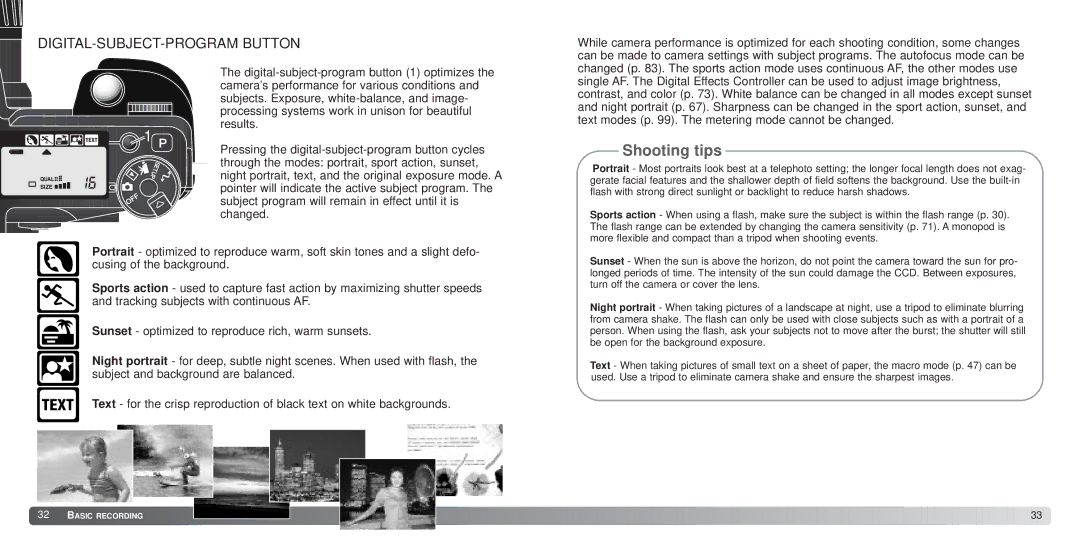
DIGITAL-SUBJECT-PROGRAM BUTTON
While camera performance is optimized for each shooting condition, some changes can be made to camera settings with subject programs. The autofocus mode can be
1 |
The
Pressing the
changed (p. 83). The sports action mode uses continuous AF, the other modes use single AF. The Digital Effects Controller can be used to adjust image brightness, contrast, and color (p. 73). White balance can be changed in all modes except sunset and night portrait (p. 67). Sharpness can be changed in the sport action, sunset, and text modes (p. 99). The metering mode cannot be changed.
Shooting tips
Portrait - Most portraits look best at a telephoto setting; the longer focal length does not exag- gerate facial features and the shallower depth of field softens the background. Use the
Sports action - When using a flash, make sure the subject is within the flash range (p. 30). The flash range can be extended by changing the camera sensitivity (p. 71). A monopod is more flexible and compact than a tripod when shooting events.
Portrait - optimized to reproduce warm, soft skin tones and a slight defo- cusing of the background.
Sports action - used to capture fast action by maximizing shutter speeds and tracking subjects with continuous AF.
Sunset - optimized to reproduce rich, warm sunsets.
Night portrait - for deep, subtle night scenes. When used with flash, the subject and background are balanced.
Text - for the crisp reproduction of black text on white backgrounds.
Sunset - When the sun is above the horizon, do not point the camera toward the sun for pro- longed periods of time. The intensity of the sun could damage the CCD. Between exposures, turn off the camera or cover the lens.
Night portrait - When taking pictures of a landscape at night, use a tripod to eliminate blurring from camera shake. The flash can only be used with close subjects such as with a portrait of a person. When using the flash, ask your subjects not to move after the burst; the shutter will still be open for the background exposure.
Text - When taking pictures of small text on a sheet of paper, the macro mode (p. 47) can be used. Use a tripod to eliminate camera shake and ensure the sharpest images.
![]() 32
32![]()
![]() BASIC RECORDING
BASIC RECORDING ![]()
![]()
![]()
![]()
![]()
![]()
![]()
![]()
![]()
![]()
![]()
![]()
![]()
![]()
![]()
![]()
![]()
![]()
![]()
![]()
![]()
![]()
![]()
![]()
![]()
![]()
![]()
![]()
![]()
![]()
![]()
![]()
![]()
![]()
![]()
![]()
![]()
![]()
![]()
![]()
![]()
![]()
![]()
![]()
![]()
![]()
![]()
![]()
![]()
![]()
![]()
![]()
![]()
![]()
![]()
![]()
![]()
![]()
![]()
![]()
![]()
![]()
![]()
![]()
![]()
![]()
![]()
![]()
![]()
![]()
![]()
![]()
![]()
![]()
![]()
![]()
![]()
![]()
![]()
![]()
![]()
![]()
![]()
![]()
![]()
![]()
![]()
![]()
![]()
![]()
![]()
![]()
![]()
![]()
![]() 33
33 ![]()
